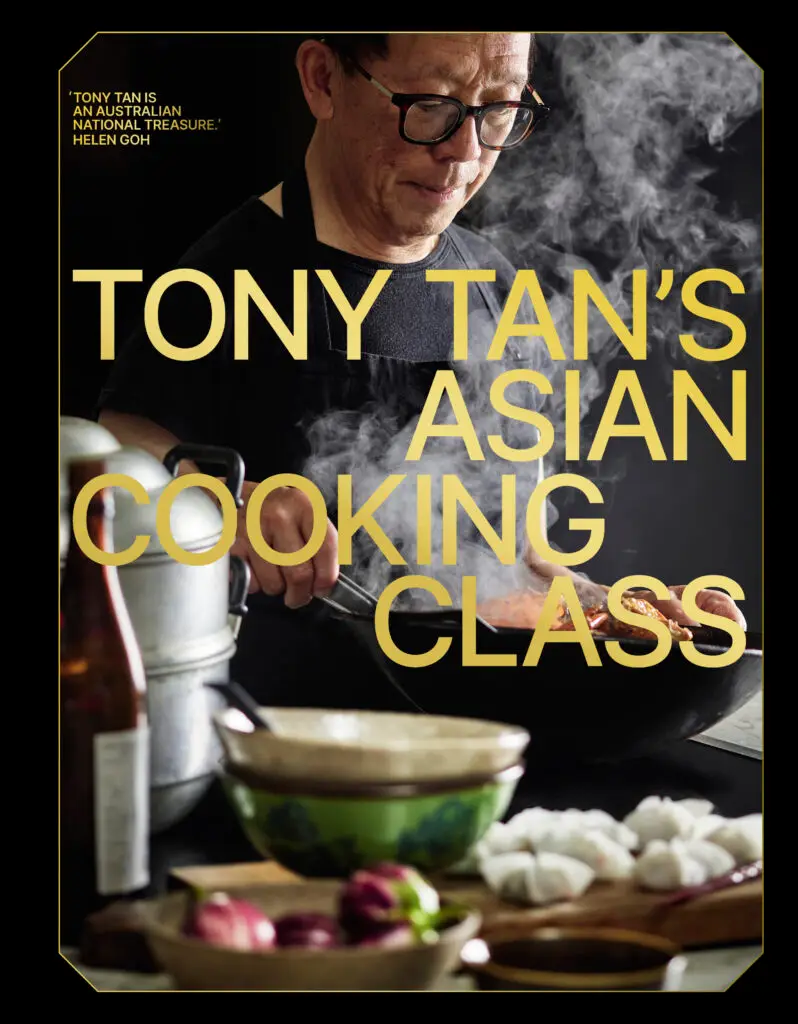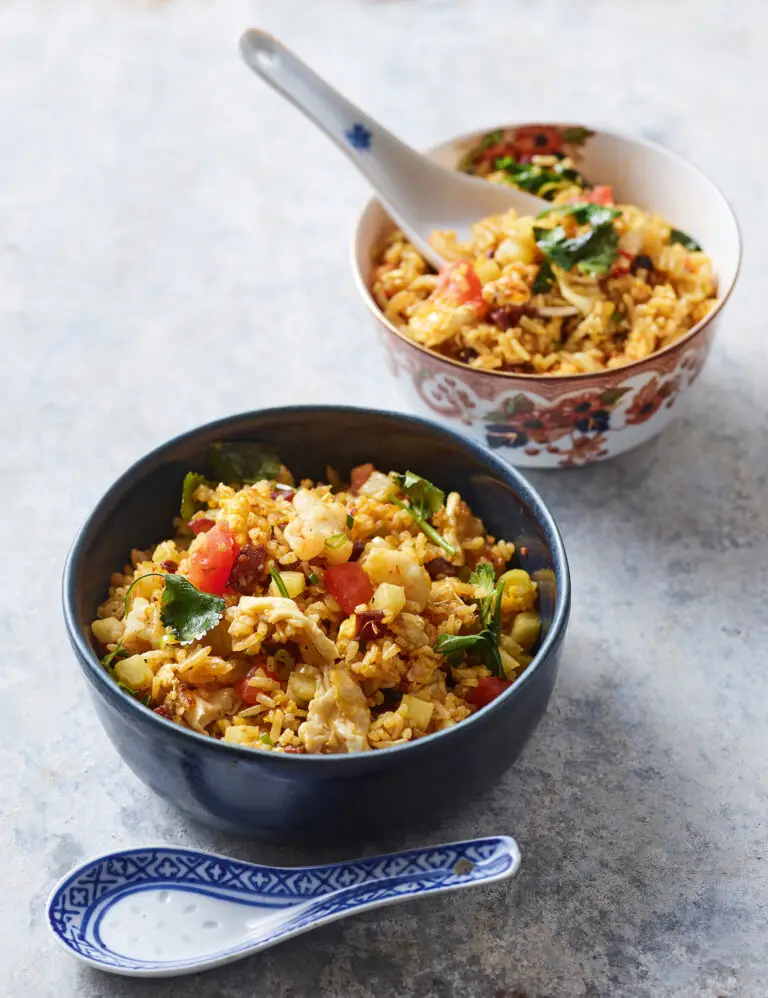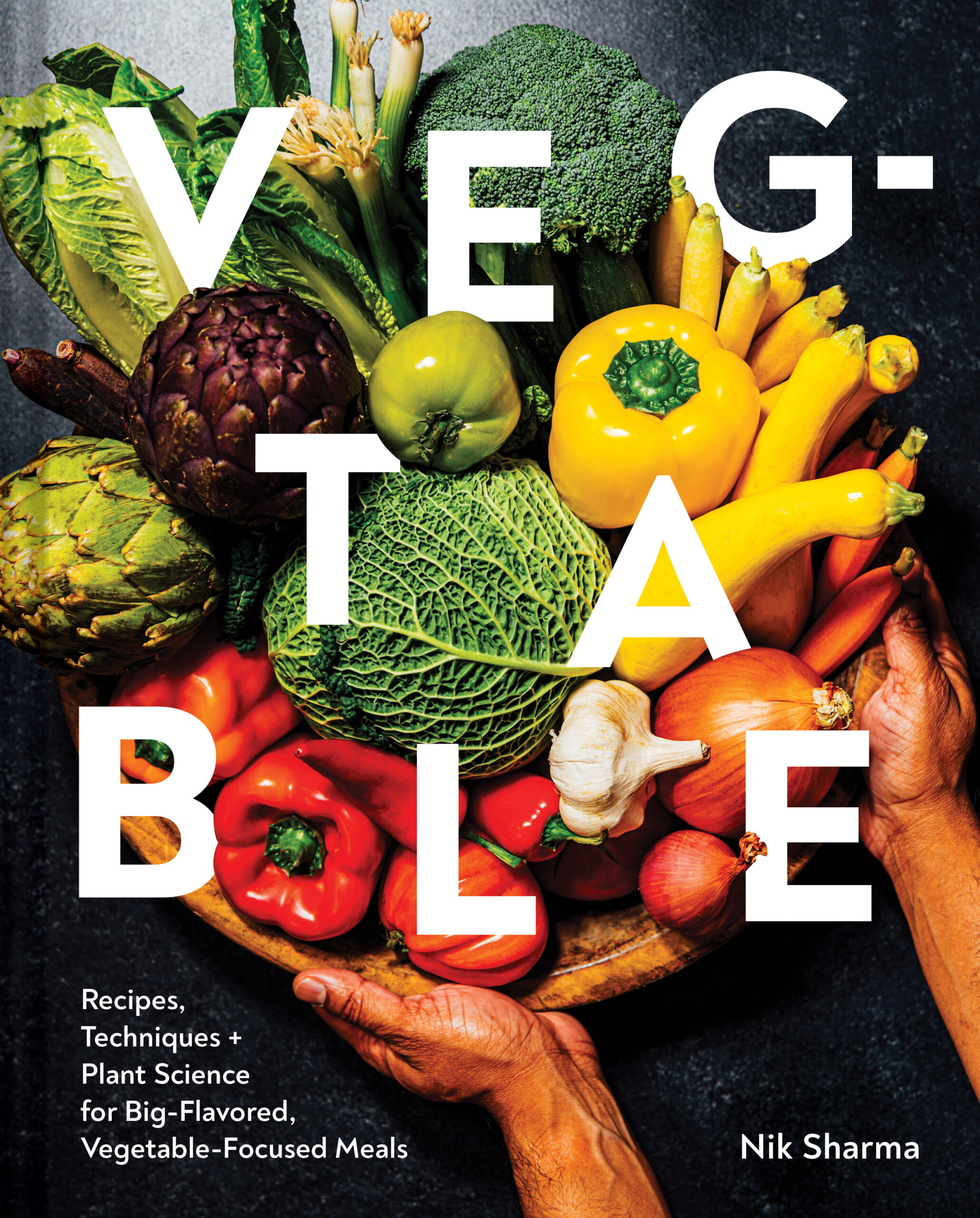

Pineapple Fried Rice (Khao Pad Sapparot): A Thai Classic with Global Roots
Fried rice is to Asia what risotto is to the West: endlessly adaptable, comforting, and beloved across cultures. Among its many variations, Khao Pad Sapparot, or pineapple fried rice, stands out as one of the most colorful and celebratory. Sweet chunks of pineapple mingle with savory lap cheong (Chinese sausage), prawns, curry powder, and day-old rice in a dish that perfectly balances contrast and harmony.
This recipe, from Tony Tan’s Asian Cooking Class cookbook, is a brilliant introduction to why pineapple fried rice has captured imaginations far beyond Thailand. It’s a dish that travels well, one you’ll see in Vietnam and even in China’s Yunnan province (where black glutinous rice may be used instead of white). And at festive tables, it’s often presented in a hollowed-out pineapple—a dazzling centerpiece that transforms a humble stir-fry into a showstopper.
The Origins of Pineapple Fried Rice
Although most commonly associated with Thailand, pineapple fried rice reflects Southeast Asia’s rich history of cultural exchange. The dish carries traces of Chinese influence through the use of lap cheong (Chinese pork sausage) and soy sauce, while local Thai flavors come through in the addition of curry powder, fresh pineapple, and fragrant herbs. Over time, cooks across borders have adapted it, adding chicken, prawns, or even chicken liver, making it a versatile and ever-evolving staple.
The key to Thai fried rice lies in the use of day-old rice. Freshly cooked rice is too moist and sticky, but rice that has cooled and dried overnight separates beautifully in the hot wok, absorbing flavors while maintaining a light, chewy texture.
What Makes This Version Special
Tony Tan’s recipe keeps the flavors in balance:
- Lap cheong lends sweetness and umami, with its caramelized edges crisping in the wok.
- Prawns bring freshness and succulence, cooking quickly in the heat.
- Curry powder adds warmth and depth, bridging savory and sweet.
- Pineapple delivers bursts of tangy-sweet acidity that cut through richness.
- Egg and aromatics (onion, garlic, scallion) round everything out with body and fragrance.
The interplay of ingredients highlights what Southeast Asian cooking does best—finding harmony in opposites.
The Science of a Good Fried Rice
The magic of fried rice isn’t just cultural; it’s scientific. The wok’s intense heat (a technique known as wok hei) promotes Maillard reactions, which develop nutty, toasty notes as sugars and proteins in the rice and aromatics caramelize.
Cooking sequence also matters: adding the egg partway through ensures fluffy, separate curds, while finishing with spring onions and coriander preserves their freshness and aroma.
How to Serve Pineapple Fried Rice
Traditionally, Khao Pad Sapparot is served straight from the wok with coriander sprinkled on top. For a festive presentation, hollow out half a pineapple and use it as a serving bowl—eye-catching and practical, since the pineapple shell helps keep the rice warm.
Pair it with:
- Thai fish cakes (tod man pla) for crunch and spice.
- A refreshing cucumber salad with rice vinegar dressing.
- Chili sauce or sambal for those who crave extra heat.
A Dish That Travels
Much like rendang in Indonesia, pineapple fried rice tells a story of migration and exchange. From Chinese traders introducing lap cheong to Southeast Asia, to Thai cooks adapting rice dishes with local fruits and spices, it’s a recipe that speaks to cultural crossroads. And it continues to evolve—today you’ll find versions with cashews, raisins, or even vegetarian spins featuring tofu and mushrooms.
Tony Tan’s Asian Cooking Class
If this recipe inspires you, I highly recommend picking up your own copy of Tony Tan’s Asian Cooking Class. It’s filled with beautifully written recipes that showcase his deep knowledge of Asian cuisines and his gift for teaching. You can also explore more about Tony’s journey and classes through Tony Tan’s Cooking School, where his passion for food and sharing knowledge truly shines.
Print
Tony Tan’s Fried Rice with Pineapple/ KHAO PAD SAPPAROT
5 Stars 4 Stars 3 Stars 2 Stars 1 Star
No reviews
Fried rice in Asia is what risotto is to the West: it comes in hundreds of guises and it always pleases just about any diner. The following recipe from Thailand is intriguing because I have seen it in Vietnam as well as in China’s Yunnan province (although black glutinous rice is used instead). You can use chicken, prawns, chicken liver or any ingredient that catches your imagination. And, if you really want to go all out, you can do as some restaurants do and serve it in a hollowed-out pineapple.
- Yield: 2 to 4
Ingredients
¼ cup [60 ml] camellia tea oil (from health-food shops), or any neutral oil, plus an extra tablespoon
2 lap cheong (Chinese sausage), diced
2 garlic cloves, finely chopped
2 to 3 Tbsp finely chopped onion, to taste
1 tsp curry powder
3 large prawns (about 4½ oz [130 g] total), peeled, deveined and chopped
1 egg, lightly beaten
Large pinch of white sugar
2 Tbsp soy sauce
3 cups (about 1 lb 3 oz [550 g]) cooked medium-grain white rice (preferably day-old), grains separated
½ cup [80 g] diced pineapple
1 firm tomato, coarsely chopped
1 spring onion (scallion), thinly sliced
1 cilantro sprig, chopped
Instructions
- Heat a wok or large frying pan over medium-high heat. Add the ¼ cup oil, swirl to coat, then add the lap cheong and stir-fry for 1 minute or until just crisp.
- Transfer to a plate, reserving the oil in the wok. Reduce the heat to medium, add the garlic and stir-fry until fragrant and just beginning to colour (about 30 seconds).
- Add the onion and curry powder and cook, stirring constantly, until fragrant, then add the prawns and stir-fry for 2 minutes until almost cooked through. Push all to the side.
- Add an extra tablespoon of oil and pour in the egg, scramble for a minute, then add the sugar and soy sauce, and immediately stir in the cooked rice. Stir until well coated and the grains are nicely separated and starting to pop, then add the pineapple, tomato and crisp lap cheong, reduce the heat to low and mix gently until hot.
- When everything is hot, add the spring onion and toss it through. Serve sprinkled with coriander.
Notes
Lap cheong (Chinese pork sausages) are sold in plastic packets in Asian grocers. If you can’t find lap cheong, crisp-fried spicy chorizo is fantastic as an alternative.

